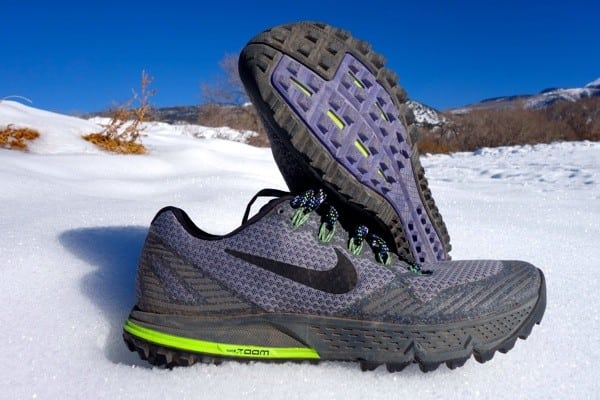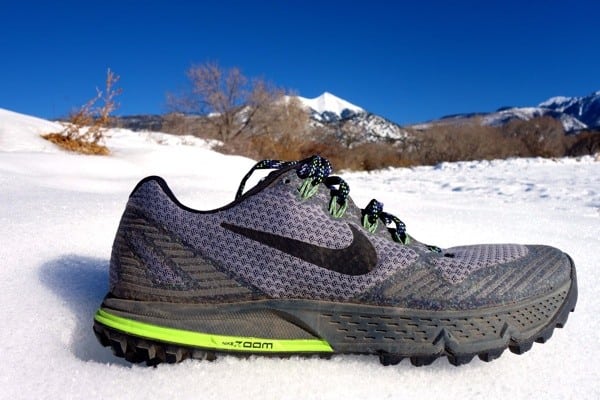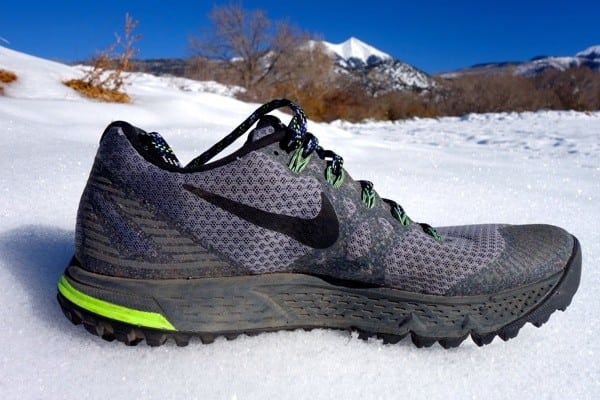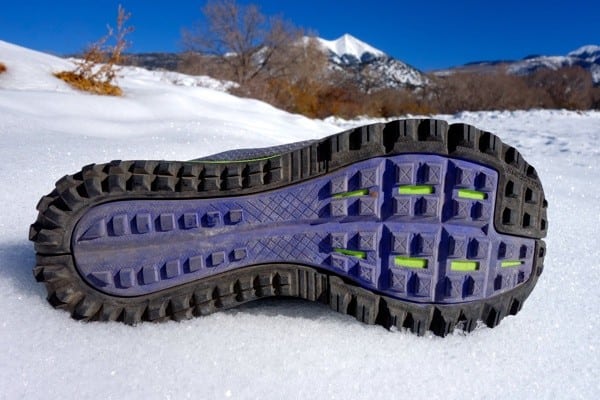Our Favorite Trail Running Shoes
Check out our Best Trail Running Shoes article to learn about our current favorite trail running shoes!
Nike Zoom Wildhorse 3 Review
The middle ground in trail running does seem to be skewed slightly to maximal recently, and updates to trail shoes that were svelte and nimble in the past now seem to be catering to legions of angry shoe buyers who mysteriously blow out uppers in less than 100 miles. What on earth are you running on/through, talus fields? I digress. The bottom line is that over the past year and into the near future, it seems that companies are capitalizing on the low cost of crude oil to create bigger and stickier outsoles covering bigger stack heights of foam, and the pendulum appears to continue to swing this way for 2016.
Meanwhile, Nike continues to churn out variations and exotic colorways of their now-flagship trail running shoes, the Terra Kiger and the Wildhorse. The first two iterations of the Wildhorse built nicely upon one another and you can read our review of the first and the second. With the release of the Nike Zoom Wildhorse 3 ($110), it was apparent that a complete redesign had taken place and a much-burlier shoe was created with the longer end of ultrarunning distances in mind. While the Wildhorse was always intended to be the beast of burden of the two shoes, this third release was something completely different with a more-durable outsole, a rock plate, and a higher stack height. The first two editions of the Wildhorse weren’t quite enough shoe for me over the 50-to-100-mile distances, so these additions were welcome. Over the course of six months of testing this shoe, I’ve come away with a somewhat conflicted opinion on the Wildhorse 3.

The Nike Zoom Wildhorse 3. All photos: iRunFar/Bryon Powell
Upper
The Wildhorse started with an upper of thin ripstop nylon, progressed to a lightweight mesh, and this new version has some of the most heavy-duty, dual-density mesh I’ve seen on a trail shoe. This mesh is lined on the inside with a very soft nylon type of material that is almost seamless. This makes the Wildhorse 3 very plush feeling initially, and this is all complimented by a well-padded heel collar and a wide tongue. The lacing system employs flywire technology to provide a very snug feel around the midfoot, without any pressure points over the surprisingly wide forefoot. Wipe out any notions of a wide Nike, as this Wildhorse is significantly wider than any of the previous versions in the forefoot of the shoe.
My favorite aspect of the Wildhorse 3’s upper is that Nike uses welded-on overlays made of their re-grind material to provide durability and protection around the toe box and rand of the shoe, without sacrificing flexibility. In fact, after over 350 miles in this shoe, the upper is showing no wear whatsoever. Now I’m not very hard on shoes, but usually at this point in a shoe’s life I’m showing some fraying on the sides of the toe box. Well done Nike, in my opinion you absolutely nailed the upper of this shoe.

The Nike Zoom Wildhorse 3 lateral upper.
Midsole
Nike adds 6 millimeters of midsole foam to the Wildhorse 3 (28mm/20mm) and this additional cushioning and 8 mm stack height is immediately noticeable. Phylon midsole EVA continues to provide semi-firm cushioning, and with more of it available, the Wildhorse 3 loses a lot of ground feel and becomes fairly stiff. This is a lot of high-durometer foam that doesn’t really loosen up throughout the life of the shoe. This experience is exacerbated by the addition of a rock plate which may have been more effective with the less cushioning on the last model. The result of all of this is a trail shoe that feels less stable and allows for very little foot flexibility which led to a great deal of irritability in my forefoot over the course of long runs.
The Wildhorse 3 has the same Zoom Air pockets in the heel which have always worked great in this shoe, however the forefoot has always felt somewhat uninspired which led me to favor the Terra Kiger which has additional air pockets in the forefoot. Again, the stiff forefoot caused me to reach for other trail shoes when I was going to be out for longer than two hours.

The Nike Zoom Wildhorse 3 medial upper.
Outsole
The classic waffle sole is iconic in the shoe industry, and Nike beefs up this design with the addition of 4mm beveled lugs covering the entire outsole. While these lugs grab very well on dry terrain, the proximity of the lugs becomes a major problem in mud or clay as they simply clog up. Even trying to clean them on a sharp rock becomes an annoyance due to this outsole’s tendency to get completely caked and not let go.
The interior of the outsole is comprised of softer and very tacky rubber which was surprisingly durable, while the edges of the outsole have high-abrasion carbon rubber. The outsole is showing very little wear for me and I think that the tacky rubber could be used over the entirety of the outsole. With the high-abrasion rubber on the edges of the shoe I believe it increased the propensity for ankle rolling and instability as the combination of dense midsole, substantial rock plate, and hard outsole rubber don’t absorb a whole lot of shock and you just seem to bounce off of everything.

The Nike Zoom Wildhorse 3 outsole.
Overall Impressions
My pair of size 10s weigh in at about 11 ounces, increasing the weight from the original Wildhorse by about 2 ounces. Now, there is significantly more durability here for those of you running through fields of broken glass, but a once light-and-agile trail shoe being relegated to the 11-ounce range is a little bothersome. I appreciate the idea of differentiating the Wildhorse from the Kiger and creating a trail shoe that can handle the 100-mile distance, however I think Nike swung too far to the other extreme.
Now, there are many runners who will completely disagree with me and enjoy this bulked-up Wildhorse. Take, for instance, Nike-sponsored runners David Laney and Tim Tollefson. Both chose the Wildhorse 3 for the duration of their breakthrough runs at the UTMB and CCC races which feature rocky, technical terrain, mud, and steep up and downhill sections. I do think that Nike made a protective and very durable trail shoe with the Wildhorse 3 that will work for some people. However, I think that the high weight and inflexibility will bother a lot of runners who were simply looking for an update to their favorite shoe.
Seeing that prices on the Wildhorse 3 have recently been reduced, and with Nike’s famously quick turnover of their models, we can probably expect to see a Wildhorse 4 in the not-so-distant future. In my opinion, it would be a welcome update to see this upper on a slightly lower stack height with a less-substantial rock plate to offer more flexibility and agility on the trails.
Call for Comments
Let us know what you thought of the Wildhorse 3, why you liked or didn’t like it, and what you’d like to see incorporated in this shoe for future models.
